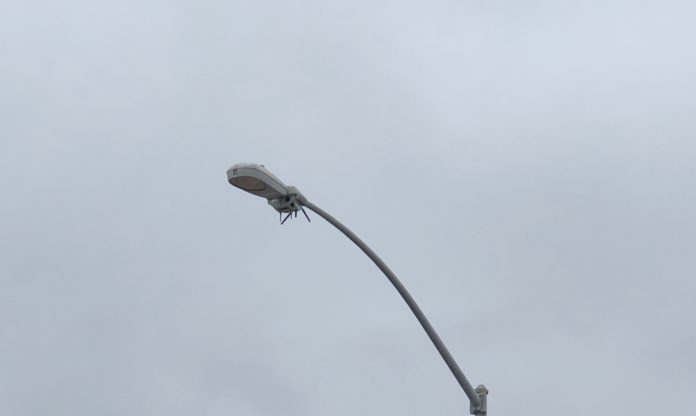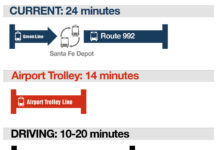Blessing or Curse?
Now that the City has almost completed upgrading thousands of street lights to “smart,” the City’s Sustainability Department is busy briefing residents on the advantages of them and asking for suggestions on how to use the captured metadata for enhanced mobility purposes, such as detecting vacant parking spaces.
What is a “smart” street light, you might ask? If you look up at street lights around Clairemont, particularly at major intersections (where you might find two of these new lights), you’ll see a light that is about the size of a loaf of bread with an object on top about the size of half a can of soda. These are the new LED lights which are brighter, more efficient, i.e. cheaper to run, and are programmable as to the on-off cycle. In addition, some of these new lights are sensors. You can tell them by the cube sitting behind the light with antennas pointing down.
The sensors monitor temperature and have a built-in camera recording 24/7. Software then detects movement of people and cars and converts this to “metadata” which can be made available to the public for use in enhancing public good. No personally identifiable data is recorded.
At a recent meeting I attended, I asked if the new lights would interfere with night sky observations from Palomar Observatory. I was told that the lights are directed downward and “comply with all City regulations for street lights,” whatever that means. Presumably the answer is “No, the new lights don’t interfere.”
Obviously with lots of cameras around town, there are privacy concerns. Here is what I learned – cameras are fixed, pointed down and do not pan, tilt, zoom or magnify, i.e. are not moveable. During installation, the technician permanently masks out private property that might appear in the view, so that only street views are provided. The video is only stored for 5-days is and automatically deleted. Because the cameras are located high up and point down, they do not provide facial or license plate recognition.
Also, video is not sent over the network and not stored in the cloud as both are too expensive. As well, only the Police Department has access to the raw video, and only by request in conjunction with a crime, either in progress, or having been committed a few days before erasure.
Here is a link which shows the installation of the lights around town. (Note that it takes a moment to load and you can easily zoom in or out).
https://cityiqmapsd.herokuapp.com/
Here is a link to read a lot more about the program, including the privacy policy and to request access to the metadata
https://www.sandiego.gov/sustainability/energy-and-water-efficiency/programs-projects/smart-city
The next public meeting in Clairemont to present the smart street lights program is July 24, 2019, 5:30- 6:45 pm, South Clairemont Rec Center, 3505 Clairemont Drive.
One question that you might ask is – since the sensors are on a wireless network, do they consume bandwidth that is also used for residential use, thus restricting residential access? Another question – with so many sensors now installed, what is the additional EMF load factor that residents at ground level are exposed to? Also, if you have thoughts on how best the City can use the new technology to provide updated services to residents and businesses, please bring them.
At a later point, the sensors can be upgraded to provide audio for gunshot location, not for voice recording.
Basically, this is a win-win-win scenario for the City, residents and programmers, but will be a surprise to most people because they hadn’t heard about it.




